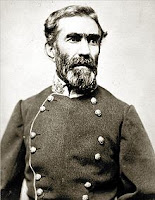150 years ago on today's date in 1863, a legendary battle began at the crossroads of the county seat of Gettysburg, Pennsylvania. It will be known as the Battle of Gettysburg, and it will become the battle with the largest number of casualties in the war.*
After his success at Chancellorsville, Virginia, in May, Lee led his victorious army through the Shenandoah to begin his second invasion of the North. He intended to shift the focus of his summer campaign away from war-damaged Virginia, and he hoped his penetration into Pennsylvania would influence Northern politicians to give up on the war. It is one of the few times in the North-South conflict that the ravages of warfare were brought home to Northern states.
Gen. Robert E. Lee concentrated his full strength against Maj. Gen. George G. Meade’s Army of the Potomac at Gettysburg. On July 1, Confederate forces converged on the town from west and north, driving Union defenders back through the streets to the low ridges of Cemetery Hill. During the night, reinforcements arrived for both sides.
On July 2, Lee attempted to envelop the Federals, first striking the Union left flank at the Peach Orchard, Wheatfield, Devil’s Den, and the two Round Tops with Longstreet’s and Hill’s divisions, and then attacking the Union right at Culp’s and East Cemetery Hills with Ewell’s divisions. But by evening, the Federals retained Little Round Top and had repulsed most of Ewell’s men.
During the morning of July 3, the Confederate infantry was driven from its last toehold on Culp’s Hill. In the afternoon, after a preliminary artillery bombardment, Lee attacked the Union center on Cemetery Ridge. The famous "Pickett’s Charge" momentarily pierced the Union line, but it was driven back with severe casualties. To the east and south, Stuart’s cavalry attempted to gain the Union rear but was repulsed.
On July 4, Lee was forced to begin withdrawing his army toward Williamsport on the Potomac River. His train of wounded stretched more than 14 miles.
Not so well known is another important conflict between Northern and Southern armies, the Tullahoma Campaign, fought over the same period in Middle Tennessee. As Lee was retreating from Gettysburg, the last shots were fired in the Tullahoma Campaign as Gen. Braxton Bragg withdrew his army from Tennessee. And yet a third Confederate defeat took place on July 4: Gen. John C. Pemberton surrendered his army at Vicksburg to Gen. Ulysses S. Grant. July 4th, 1863, will prove to be one of the darkest days for the Confederacy.
Not so well known is another important conflict between Northern and Southern armies, the Tullahoma Campaign, fought over the same period in Middle Tennessee. As Lee was retreating from Gettysburg, the last shots were fired in the Tullahoma Campaign as Gen. Braxton Bragg withdrew his army from Tennessee. And yet a third Confederate defeat took place on July 4: Gen. John C. Pemberton surrendered his army at Vicksburg to Gen. Ulysses S. Grant. July 4th, 1863, will prove to be one of the darkest days for the Confederacy.
 |
| Gen. Robert E. Lee |
 |
| Gen. Braxton Bragg |
 |
| Gen. John C. Pemberton |
Sources: CWSAC Battle Summaries; The Army of Tennessee, Stanley F. Horn
No comments:
Post a Comment